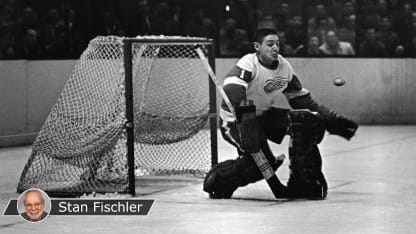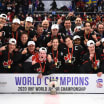Legendary hockey reporter Stan Fischler writes a weekly scrapbook for NHL.com. Fischler, known as "The Hockey Maven," shares his humor and insight with readers each Wednesday.
This week Fischler reveals how Hockey Hall of Famer Jack Adams developed an amazing knack for finding top goalies over three decades as a manager with the Detroit Red Wings.
Adams had knack for discovering elite goalies with Red Wings
Acquired Lumley, Sawchuk, Hall among others during 36-year run as general manager

By
Stan Fischler
Special to NHL.com
No NHL executive has had as good fortune at discovering elite goalies as former Detroit Red Wings boss Jack Adams.
Adams had the uncanny ability to find the right goalie at the right time, beginning in 1934 when the Red Wings acquired Normie Smith from the Montreal Maroons. Smith helped Detroit win the Stanley Cup in 1936 and 1937 and led the League in wins each season. He starred in the longest game ever played in the NHL, when he made 92 saves in a 1-0 win against the Maroons that was decided at 16:30 of the sixth overtime on March 24, 1936.
Smith merely was the first in Adams' production line of quality goalies. His next ace arrived in 1940 when future Stanley Cup and Vezina Trophy-winner Johnny Mowers signed with the Red Wings. Adams' goalie magic lasted until the mid-1960's when his final discovery, Roger Crozier, became the first player from a losing team to win a Conn Smythe Trophy voted as MVP of the Stanley Cup Playoffs.
Between the reigns of Mowers and Crozier, Detroit's minor league farm teams produced such legendary goalies as Harry Lumley, Terry Sawchuk and Glenn Hall, each a Hall of Famer.
Mowers was the first to emerge from the Red Wings farm system, after being discovered by Detroit's scout Carson Cooper while playing senior hockey in his hometown of Niagara Falls, Ontario.
"At the time we already had a great goalie in Tiny Thompson," said Adams, "but he was getting old and Carson assured me that Mowers was ready."
After a heartbreaking seven-game loss in the 1942 Cup Final against the Toronto Maple Leafs, Mowers rebounded the following season, winning the Vezina Trophy voted as the top goalie in the NHL. His game peaked in the 1943 Final when Detroit swept the Boston Bruins in four games. Mowers did not allow a goal in each of the final two games.
But World War II duty called and Mowers joined the Royal Canadian Air Force, leaving Adams in a bind. Meanwhile, his birddogs found a talented teenager in Owen Sound, Ontario. At age 17 years and 38 days old, Lumley made his NHL debut in a 6-2 loss to the New York Rangers on December 19, 1943. But he needed seasoning and after a stint with Indianapolis in the American Hockey League Lumley returned to the Red Wings to stay in 1945. Five years later, he helped lead Detroit to the Stanley Cup, winning Game 7 against the Rangers in double overtime.
After winning the Cup in 1950, the Red Wings traded Lumley to the Chicago Blackhawks.
"I had this 'can't-miss' kid at Indianapolis -- Terry Sawchuk -- who was too good to be true," Adams said. "I couldn't keep him down there, so I traded Lumley and never regretted it."
From his rookie season in 1950-51 through 1954-55, Sawchuk's goals-against average was less than 2.00 each season and he had 56 shutouts. Meanwhile the Red Wings won the Stanley Cup in 1952, 1954 and 1955.
"Terry was the greatest goalie I ever saw," said Emile Francis, himself a former Blackhawks and Rangers goalie and later an NHL executive.
While many historians have since agreed with Francis, Adams again heeded the call from his scouts that Indianapolis had developed yet another goalie prodigy, a kid out of Humboldt, Saskatchewan, named Glenn Hall. Sawchuk was traded to the Bruins and Hall replaced him. In his first full season, 1955-56, the man they would eventually nickname "Mister Goalie," had 12 shutouts in 70 games, won the Calder Trophy voted as the top rookie in the NHL and was named a second team all-star.
"When it came to consistency between the pipes," Ryan Kennedy wrote in The Hockey News, "no one will ever touch Glenn Hall. He became the benchmark of steadiness, in part, by falling down."
Kennedy referred to Hall's then innovative style of dropping to his knees in an inverted-V formation to stop pucks. It became known as "The Butterfly" and soon was copied by other goalies.
"Nobody came close to Hall when it came to great goaltending," said Hall of Fame forward Andy Bathgate, who played for the Rangers, Maple Leafs and Red Wings. "He was solid in every way. He had a great pair of hands, fast legs, and he played those angles. Plus, he was smart."
However, a vicious slap shot delivered by Bruins forward Vic Stasiuk struck Hall in his maskless face during the 1957 playoffs, knocking him out cold. Despite the career-threatening blow, Hall returned and continued to play. Adams said little at the time but was not terribly impressed.
"Jack and I didn't get along well right from the start," Hall said, "and he got the idea that I wasn't the same top-notch goalie after that injury. That was a blow to my confidence; no question about it."
Convinced that Hall had become "puck-shy," the Red Wings traded the goalie to Chicago and brought Sawchuk back to Detroit. Although Adams was fired in 1963, he already had been touting another AHL prospect, Crozier, as Sawchuk's replacement. Even though the Red Wings fired Adams, his final goalie choice proved to be another fabulous find.
Crozier immediately demonstrated he was big on guts during his first NHL game in 1963-64 when he took a Frank Mahovlich slap shot in the face. Although the blow broke Crzoier's jaw, he finished the game. After completing his next season as Detroit's full-time starter, Crozier won the Calder Trophy.
When Jack Adams heard the news, he enjoyed a good, long-distance "I told you so" laugh from behind his desk as President of the Central Hockey League!

















